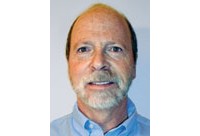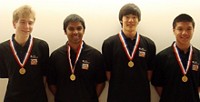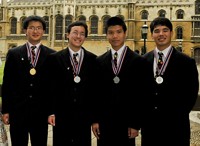Advertisement
Grab your lab coat. Let's get started
Welcome!
Welcome!
Create an account below to get 6 C&EN articles per month, receive newsletters and more - all free.
It seems this is your first time logging in online. Please enter the following information to continue.
As an ACS member you automatically get access to this site. All we need is few more details to create your reading experience.
Not you? Sign in with a different account.
Not you? Sign in with a different account.
ERROR 1
ERROR 1
ERROR 2
ERROR 2
ERROR 2
ERROR 2
ERROR 2
Password and Confirm password must match.
If you have an ACS member number, please enter it here so we can link this account to your membership. (optional)
ERROR 2
ACS values your privacy. By submitting your information, you are gaining access to C&EN and subscribing to our weekly newsletter. We use the information you provide to make your reading experience better, and we will never sell your data to third party members.
Education
Movers And Shakers
C&EN Talks With Christopher Hillenbrand
Since he was a child, the high school student and International Chemistry Olympiad gold medalist hasn’t been able to keep his hands off science
by Emily Bones
May 20, 2013
| A version of this story appeared in
Volume 91, Issue 20

Three years ago, Christopher Hillenbrand aced the Advanced Placement (AP) Chemistry test. He was only 12 years old. Now, as a sophomore—the year when many U.S. teenagers learn the ins and outs of the periodic table—Hillenbrand doesn’t take any science classes at school. Instead, he travels to nearby Columbia University and New York University after school and on weekends to quench his thirst for chemistry.
Hillenbrand has been advanced in his studies from a young age. Chemistry first caught Hillenbrand’s eye at the age of five when a family friend gave him “The Usborne Internet-Linked Science Encyclopedia.” He gravitated to the chemistry section, so his father gave him “Chemistry for Dummies.” Knowing about his chemistry interest, another family friend gave Hillenbrand $100 to spend on books. After perusing the shelves at Barnes & Noble, he chose a volume “with a nice orange cover, and it had a nice drawing inside,” Hillenbrand recalls. It was a chemistry textbook. “I never really read it through cover to cover; I just skipped around and learned stuff.”
Since third grade, Hillenbrand has been in advanced classes at school. Through middle school, he attended the Wardlaw-Hartridge School, in Edison, N.J., where administrators and teachers were flexible and accommodated his advanced abilities. For example, when he was in sixth grade he took high school chemistry, and because of his early exposure to the topic, he found the course simple. But it was a reading assignment for this class that Hillenbrand credits as the spark of his passion for chemistry—“Uncle Tungsten: Memories of a Chemical Boyhood,” by Oliver Sacks. “It’s a really good book,” he says, “It is about Oliver Sacks’s home chemistry lab and how he had lots of fun when he was in grade school. So then I wanted to make a lab.”
With his parents supervising, Hillenbrand began experimenting at home to test chemical concepts. He learned about procedures with the help of the Internet. “I used Wikipedia. I read a lot of Wikipedia chemistry pages for fun,” he says.
By the age of 12, he was making chemical gardens, which are reactions between metal salts and aqueous sodium silicate that result in colorful “hairy” products that look like a garden. He also purchased a pound of copper sulfate on eBay. “I mixed copper sulfate with ammonia and got the deep-blue copper ammonia complex, which looked really nice but smelled really bad,” Hillenbrand recalls. He did all this in his kitchen.
But it wasn’t until eighth grade that he fully established his home lab. He transformed the back porch of his family’s home in New Jersey into his workspace. He continues to stock his lab with supplies purchased over the Internet, and he finds experiments on the Web to try in his lab.
A year after creating his lab, he was browsing the Internet and stumbled across a website about the 2011 International Chemistry Olympiad (IChO), an annual international chemistry competition for high school students. The event intrigued him, “So I signed up for the local test and I took it, then I took the national test, and then I went to the study camp and there was a test every other day. And then I took another test. And that’s the end. Do you want the serious version of that?” he jokes.
To prepare for the sequence of rigorous tests, Hillenbrand studied advanced textbooks and worked with a tutor. After qualifying as a national finalist, Hillenbrand joined the 19 other top-ranking students for a two-week intensive preparation camp at the U.S. Air Force Academy, in Colorado.
There, the students studied, conducted experiments, and were evaluated. “Something that stood out was organic synthesis,” he says enthusiastically. “We took aromatic amines and aldehydes and made imines.” This is not a procedure many high school students are familiar with.
Hillenbrand was the youngest team member of the 2012 IChO team. He earned a gold medal last July—the only gold medal earned by the four U.S. team members.
Because he took AP Chemistry in middle school, there are no classes for him to take at Regis High School, the school he currently attends in New York City. So Hillenbrand attends a science honors program at Columbia for two hours on the weekends. He also works in biochemist Nadrian C. Seeman’s lab at NYU after school and on weekends to sharpen his research skills. “I help do the gel electrophoresis and other steps in the DNA purification process,” Hillenbrand explains.
His studies aren’t the only thing that sets him apart from a typical teenager. Hillenbrand has become an advocate for science, technology, engineering, and mathematics education. He has strong opinions, and he’s been provided opportunities to share his thoughts on the importance of STEM education from firsthand experience. In December 2012, he was recognized by the American Chemical Society New York Section for his IChO accomplishment. At the event, Hillenbrand spoke about what works in school and what doesn’t. “If students are given more exposure to lab work, they will become more interested in the subject,” he said. “When the chemistry curriculum consists of abstract and bland topics in high school, I think it is difficult for students to sustain interest.”





Join the conversation
Contact the reporter
Submit a Letter to the Editor for publication
Engage with us on Twitter